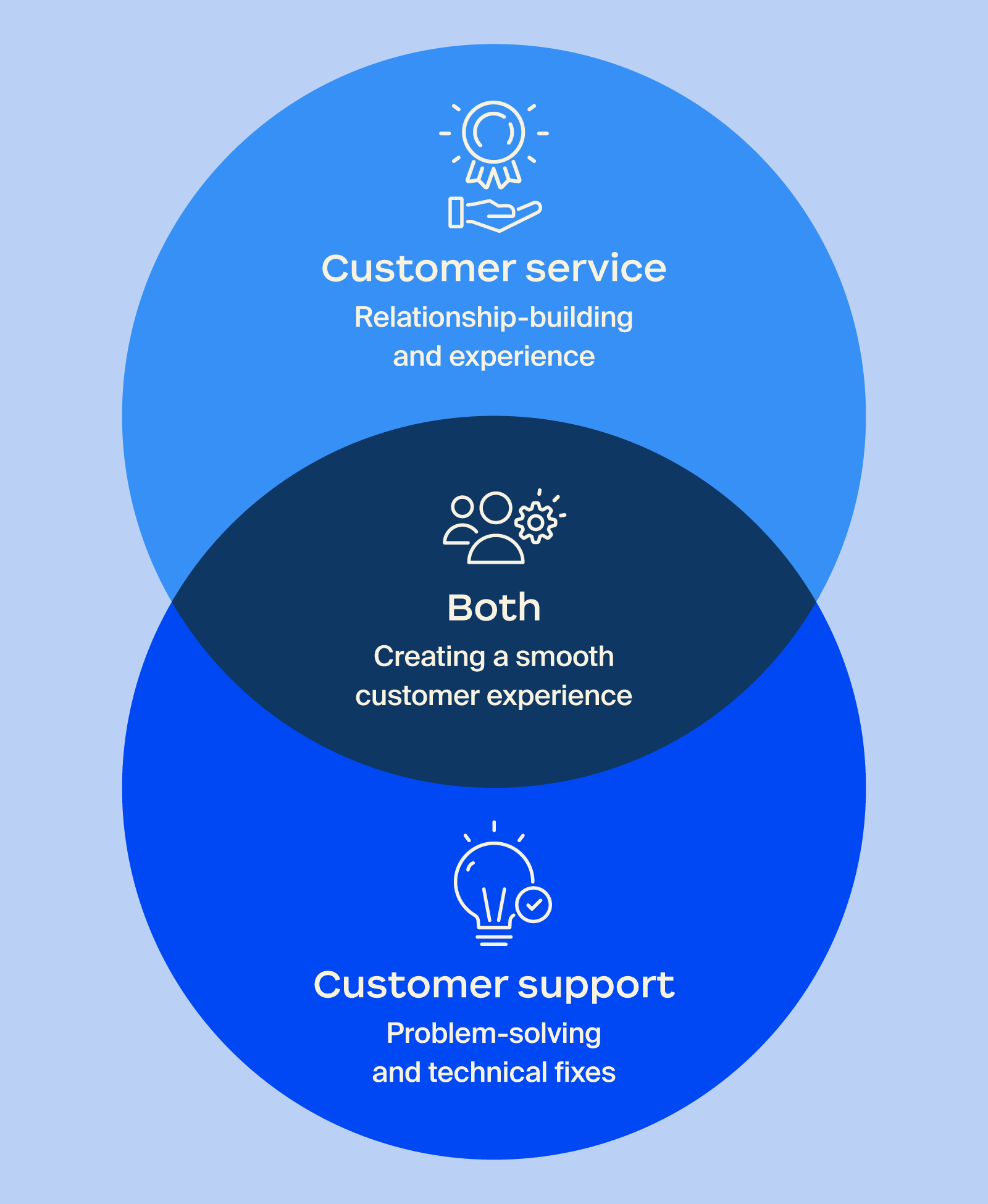
Meet Zoom AI Companion, your new AI assistant!
Boost productivity and team collaboration with Zoom AI Companion, available at no additional cost with eligible paid Zoom plans.
Updated on July 30, 2025
Published on July 30, 2025


Sixty percent of customers would switch to a competitor after only one or two negative experiences with a business (Morning Consult, 2025). Needless to say, it’s important to avoid those experiences.
To do that, you need to understand the difference between customer service and customer support, and make sure both are running smoothly at your organization. Doing so helps you increase customer retention, improve your brand image, and drive long-term growth.
This guide breaks down the key differences between customer service and customer support, why both matter, and how to optimize each with proven tips and best practices.
Customer service helps ensure that customers have a positive experience in all their interactions with your company and get the maximum value from your products or services. Customer service is provided at each phase of the customer journey, from onboarding new clients to customer retention.
Customer support is the assistance you provide clients when they have technical issues. Good customer support is part of providing good customer service, but it is just one part.
The chart below shows some of the key differences between customer service vs. customer support.
|
Customer Service |
Customer Support |
|
Provided during all interactions with potential, current, and past customers |
Provided when a customer has a technical issue and needs help resolving it |
|
Affects all businesses and customers |
Primarily affects companies and individuals dealing with technical products, such as Software as a Service (SaaS) |
|
It’s non-technical; all employees within the company provide customer service |
It’s technical and requires a dedicated team capable of answering questions |
|
Involves long-term proactive and reactive interactions |
Involves short-term, reactive interactions |
Companies need to provide both good customer service and customer support — but customer service is the more holistic of the two.
Customer service includes support, but it goes beyond troubleshooting. It refers to how your customers are treated at every stage of their journey with you — from the first time they visit your website to post-purchase interactions.
This plays a major role in shaping the overall customer experience. Every interaction — whether it's a live chat, an email response, or even how easy your return policy is — contributes to how people feel about your brand and whether they'll stay loyal or churn. This includes:
Every team member provides customer service when they interact with consumers, including call center reps, AI chatbots that answer initial questions, and the team that consumers call when they have technical issues.

Customer support is required when a company sells hardware, software, or other products that consumers need help using. Folks reach out to companies for support when specific issues arise, and a dedicated department or agent with a deep understanding of the product offers specialized help. Customers may reach out with questions about:
Customer support staff may also run usability studies on products to minimize technical problems and create instruction manuals and other documentation to help consumers use products effectively.
Post-support surveys can provide valuable insights. Questions focus on things like how satisfied clients are with your response to a request for help and how quickly the team solved their problem. Fast, efficient, and knowledgeable technical help is the key to providing effective customer support.
While knowing the difference between customer service vs. customer support is important, it’s even more essential to know how to provide effective service and support.
Customers who are dissatisfied with any interactions they have with your business are likely to look to competitors in the future. It’s much more expensive to acquire new clients than to keep existing ones happy, so you don’t want to lose your clients because of poor service or support.
People who have a negative support experience are likely to share it, according to a 2022 Morning Consult survey commissioned by Zoom. In fact, 57% said they’d tell a friend or family member to avoid the company, and over one-third would write a negative online review. You want to earn business by referrals from satisfied customers, not lose business due to poor reviews.
| Incorporating AI into your guest experience can help you provide timely service, personalize your support, and improve customer satisfaction. With Zoom CX, you can offer customers more ways to connect with your company for help and solve more problems on the first contact, leading to happier clients. |
If your customer satisfaction scores (CSAT) and Net Promoter Scores (NPS) are low, or your client churn is high, you may be thinking about how to improve your customer service. These 10 tips can help you exceed customer support expectations and go from meh to memorable customer service.
Customers are much happier if you anticipate problems and address issues before they occur.
For example, make it easy for customers to find the products they’re looking for, start using them quickly and easily, and access resources if they have questions.
Customer care support tools like in-app messages, tooltips, and automated emails can guide users through choosing the right product or service and starting to use it immediately before they encounter any issues that cause frustration.
Customer experience trends suggest that customer-led approaches help boost client satisfaction. This means you need to empower clients to find the answers they’re looking for quickly and easily.
A comprehensive knowledge base, answers to frequently asked questions, and AI-powered chatbots help ensure customers don’t have to wait for service or support.
They can get their questions answered immediately through readily available resources, whether they’re looking for guidance on what products or services meet their needs or have a technical issue.
No one wants to wait for help when they need help or have a question about a product or service. A centralized contact center, or hub where all customer service is managed, can make it easier and quicker for clients to get the assistance they need.
Automated tools such as chatbots and automatic call forwarding also allow customers to solve many problems without waiting for an agent, while implementing a system to prioritize urgent tickets can minimize wait time for those who need help the most.
People want to feel heard and understood. To provide good customer service, leverage customer data, such as customer satisfaction surveys and statistics on common complaints or questions, to help you provide tailored responses and a better overall experience.
If your company can anticipate and respond to customers’ specific issues or questions, the service and support you offer will feel more relevant and engaging.
People prefer to access assistance in different ways. Offering various contact methods lets customers choose what works best for them.
Offer help through chat, email, phone, text, and social media to meet customers where they are. You’ll also want to provide quick and consistent answers across all these channels, which requires effective team collaboration.
First impressions are one of the most important components of the customer experience. If you help customers avoid problems and start using your products or services seamlessly from the start, you’re providing a much better first impression.
Tutorials, webinars, and guided walkthroughs can all help customers get started quickly and immediately see how your products or services can effectively meet their needs.
Whether you’re offering customer support vs. customer service, you want every interaction to satisfy your consumers.
One of the best ways to do this is to collect client feedback regularly. Analyze support tickets and survey folks to see what aspects of service and support you’re excelling at and where you need to improve.
Things will go wrong from time to time — that’s a given. But frequent outages or bugs can quickly sour the customer experience. That’s why uptime — the amount of time your product or service is fully operational and available — is critical.
High uptime means your customers can consistently rely on your product to do what it’s supposed to do, when they need it. Pair that reliability with transparent communication when things do go wrong (like real-time status updates or proactive support emails), and you’ll build trust even during hiccups.
Customer support services should be provided by dedicated teams with plenty of training and technical expertise.
All team members offering service support need to know how to solve common client problems and answer questions about all of your products or services.
Customer service and customer support should be teamwide efforts.
Your brand’s reputation is only as good as your weakest employee, so be sure everyone, from the product team to the sales team and beyond, is prioritizing a positive experience.
Strong customer service combined with comprehensive and knowledgeable customer support is essential in every business, especially when offering technical products to consumers who may need more help.
Zoom CX offers an array of unified, AI-first customer service and support features, enabling teams to offer timely service, communicate effectively, and support long-term satisfaction.
Contact Zoom today to explore solutions that can make your customer service stand out.